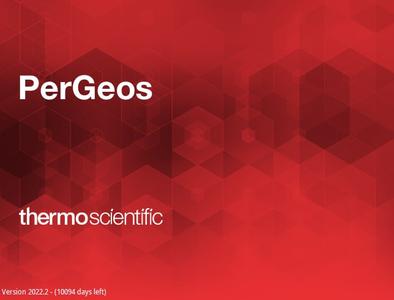Thermo Fisher Scientific PerGeos 2023.2 (x64)

Free Download Thermo Fisher Scientific PerGeos 2023.2 (x64) | 2.9 GB
From whole-core CT to SEM, Thermo Scientific PerGeos Software is a unique solution for Digital Rock Analysis trusted by Oil & Gas peers.Its visualization, processing, and analysis of 2D and 3D digital rock imagery enables improved evaluation of reservoir quality and faster understanding of static and dynamic rock properties that impact production.
Digital Rock Analysis: Run advanced geological analysis from your rock imagery data
Digital Rock Analysis ( DRA ) is the study of rock samples by use of rock imagery data with the goal of understanding rock properties.
Digital Rock Analysis encompasses a multi-disciplinary approach involving advanced microscopy and physics combined with geology, geochemistry, petrophysics, and petroleum engineering to understand the pore-scale microstructure of reservoir rock. It is used to help E&P operators reduce exploration and production risk while informing decision-making to improve recovery.
Rock core plug analysis using X-ray computed tomography
-Using whole-core X-ray CT and micro-CT plug data: Understand lamination. Analyze core and heterogeneity logs. Measure fracture density and orientation. Characterize the pore space.
-Segment pores, clays, and grains. Run accurate grain size and shape analysis. Perform advanced porosity calculation and pore size distribution analysis.
Perform multi-scale geological and petrophysical analysis of your core imaging data
-From Core to Pore, using imagery from large CT to FIB/SEM systems, PerGeos Software helps you digitally understand and validate observations and properties of your rock data with a high level of confidence.
-Ability to interpret images at multiple resolutions from multiple modalities, advanced 2D/3D and 3D/3D registration tools and adaptive thresholding make PerGeos Software a unique digital platform for powerful up-scaling workflows.
-This allows geological and petrophysical properties to be numerically obtained with confidence since all scales of the pore space can be analyzed and interpreted to calculate properties such as global porosity or relative permeability.
Digital rock analysis with focused ion beam milling
-Focused Ion Beam coupled with Scanning Electron Microscopy systems (FIB-SEMs) are invaluable tools that produce high-resolution imagery of nanoporous structures of tight reservoirs and for multi-scale analysis.
-Using FIB/-SEM image data: Quantify pores, clays, organic matter, grains. Perform 3D pore-space characterization. Analyze organic versus mineral porosity. Run 3D size and shape analysis on grains.
Whole Core CT data
-Perform geological, petrophysical, core-flooding, or Dual Energy specific analyses on virtual assemblies of your whole core CT imaging data.
-Import and pre-process CT imaging data. Assemble multiple large core scans, generate logs, perform dip and strike analyses, conduct rock typing and facies classification, generate automated reports. Evaluate and select sub-regions of interest for down-scale investigations.
Core CT plugs
-Obtain actionable insights on your core plug imagery data acquired using X-ray Computed Tomography.
-Perform rock typing, porosity estimation or saturations analysis. Extract and analyze wormholes. Use Dual Energy CT (DECT) technique to obtain actual density information that can be compared with density logs and used for further characterization of rock formations. Identify and select sub-plugs for further down-scale analysis.
Micro-CT core plugs
Microfocus X-ray tomography (micro-CT) allows to capture high-resolution imaging on core samples at the millimeter scale.
-From this imaging data, PerGeos Software allows geologists, petrophysisists and reservoir engineers to obtain advanced information on the rock micro-structure, from pore space and pore network analysis to fluid flow properties calculation, such as pore size distribution, grain classification, or absolute permeability and two-phase flow properties.
SEM rock thin sections
-Scanning Electron Microscopy (SEM) systems allow geologists to capture high-quality images of thin sections of rocks.
-PerGeos Software offers a dedicated digital platform to extract petrology or mineralogy information from this thin section imagery data. It allows for the characterization of properties such as pore size distribution, intergranular porosity, or grain shape and orientation. It also provides tools to perform mineralogical analysis using SEM-EDS data.
-PerGeos Software also provides the unique ability to perform Process-Based Modeling, which is the simulation of the formation of the rock by generating a 3D model from 2D images analyses.
Scanning electron microscopy for geological thin section analysis
-Scanning Electron Microscopy (SEM) systems allow geologists to capture high-quality images of thin sections of rocks.
-Using SEM thin sections: Perform petrography workflows. Run grains size and shape analysis, pore-space characterization. Get high-resolution mineralogy information.
-Thermo Scientific PerGeos Software is a comprehensive Digital Rock Analysis solution that provides geologists with advanced analytical tools to better evaluate the reservoir quality.
Collaborative core analysis
Multi-disciplinary sharing of information to build a common rock model
Confidence in results
Multi-scale, multi-modal image analysis to help users validate observations and properties from a variety of data sets
Consistency in data processing and modeling
Automated workflows to streamline efficiency and implement best practices
Customized for exploration & production
Dedicated software platform for oil and gas reservoir characterization and digital rock analysis
System Requirements:
OS:Microsoft Windows® 10 (64-bit). Testing on Windows® versions older than Windows® 10 has been discontinued.
GPU:PerGeos should run on any graphics system (this includes GPU and its driver) that provides a complete implementation of OpenGL 2.1 or higher (certain features may not be available depending on the OpenGL version and extensions supported). However, graphics board and driver bugs are not unusual.
The amount of GPU memory needed depends on the size of the data. We recommend a minimum of 1 GB on the card. Some visualization modules may require having graphics memory large enough to hold the actual data.
High-end graphics cards have 16 to 32 GB of memory. Optimal performance volumetric visualization at full resolution requires that data fit in graphics memory (some volume rendering modules of PerGeos are able to go around this limitation).
RAM: 32 GB may be required for a 4 GB dataset.
Home Page –
https://www.thermofisher.com/
DONWLOAD FROM RAPIDGATOR
dt99c.Thermo.Fisher.Scientific.PerGeos.2023.2.x64.rar.html
DOWNLOAD FROM NITROFLARE
dt99c.Thermo.Fisher.Scientific.PerGeos.2023.2.x64.rar
DONWLOAD FROM UPLOADGIG
dt99c.Thermo.Fisher.Scientific.PerGeos.2023.2.x64.rar
Fikper
dt99c.Thermo.Fisher.Scientific.PerGeos.2023.2.x64.rar.html